Experimental and Theoretical Investigation of Longitudinal Temperature Attenuation and Smoke Movement in Urban Utility Tunnel Fires
Abstract
1. Introduction
2. Theoretical Analysis
3. Experimental Setup
4. Results and Discussion
4.1. Smoke Movement Configuration
4.2. Initial Position of One-Dimensional Horizontal Spreading of Smoke
4.3. New Proposed Formula of Longitudinal Temperature Rise of Smoke
4.4. Spreading Velocity of Smoke
5. Conclusions
- (1)
- A nose-shaped smoke front is formed because the smoke movement of the tunnel fire belongs to the natural convection driven by thermal buoyancy, that is, the gravity current.
- (2)
- Based on non-dimensional analysis, it is found that the dimensionless initial position of one-dimensional smoke spreading increases exponentially with the dimensionless heat release rate in the correlation of . The proposed dimensionless model collapses and correlates well with the numerical results from previous studies.
- (3)
- The longitudinal temperature attenuation formula of smoke is established with a consideration of radiation heat loss. Different from the classical logarithmic equation, the transcendental equation is solved by the fzero function. It is found that the theoretical value of the longitudinal temperature rise of smoke, ΔT0, is in good agreement with the measurement.
- (4)
- The average spreading velocity of smoke increases with an increase in the heat release rate. When the fire source is located near one end of the tunnel, the velocity of smoke spreading is smaller than that of the fire source at the center, due to the long spreading route. It is suggested that the corresponding smoke exhaust speed can be determined according to the longitudinal position of the fire source. The smoke exhaust should be designed based on the larger velocity of smoke spreading. The theoretical value of the spreading velocity of smoke coincides well with the experimental value, and the relative error is less than 20%.
Author Contributions
Funding
Institutional Review Board Statement
Informed Consent Statement
Data Availability Statement
Acknowledgments
Conflicts of Interest
References
- Pan, R.; Zhu, G.; Liang, Z.; Zhang, G.; Liu, H.; Zhou, X. Experimental study on the fire shape and maximum temperature beneath ceiling centerline in utility tunnel under the effect of curved sidewall. Tunn. Undergr. Space Technol. 2020, 99, 103304. [Google Scholar] [CrossRef]
- Du, F.; Zhang, Q.; Wang, K.; Cui, W.; Guo, Y.; Deng, Y. Study on crowd evacuation in subway transfer station fires based on numerical simulation. Emerg. Manag. Sci. Technol. 2022, 2, 16. [Google Scholar] [CrossRef]
- Hua, N.; Tessari, A.; Elhami Khorasani, N. The effect of geologic conditions on the fire behavior of tunnels considering soil-structure interaction. Tunn. Undergr. Space Technol. 2022, 122, 104380. [Google Scholar] [CrossRef]
- Zhao, P.; Yuan, Z.; Liang, C.; Yuan, Y.; Xie, Y.; Yu, N. Experimental investigation on ceiling temperature characteristics induced by weak and strong fire plumes in tunnel fires equipped with two-point extraction ventilation using smoke extraction channel. Tunn. Undergr. Space Technol. 2022, 124, 104487. [Google Scholar] [CrossRef]
- Atkinson, G.T.; Drysdale, D.D. Convective heat transfer from fire gases. Fire Saf. J. 1992, 19, 217–245. [Google Scholar] [CrossRef]
- Heskestad, G.; Hamada, T. Ceiling jets of strong fire plumes. Fire Saf. J. 1993, 21, 69–82. [Google Scholar] [CrossRef]
- Chow, W.K.; Gao, Y.; Zhao, J.H.; Dang, J.F.; Chow, C.L.; Miao, L. Smoke movement in tilted tunnel fires with longitudinal ventilation. Fire Saf. J. 2015, 75, 14–22. [Google Scholar] [CrossRef]
- Gao, Z.H.; Liu, Z.X.; Wan, H.X.; Zhu, J.P. Experimental study on longitudinal and transverse temperature distribution of sidewall confined ceiling jet plume. Appl. Therm. Eng. 2016, 107, 583–590. [Google Scholar] [CrossRef]
- Kunsch, J.P. Critical velocity and range of a fire-gas plume in a ventilated tunnel. Atmos. Environ. 1999, 33, 13–24. [Google Scholar] [CrossRef]
- Hu, L.H.; Huo, R.; Li, Y.Z.; Wang, H.B.; Chow, W.K. Full-scale burning tests on studying smoke temperature and velocity along a corridor. Tunn. Undergr. Space Technol. 2005, 20, 223–229. [Google Scholar] [CrossRef]
- Ye, K.; Zhou, X.; Zheng, Y.; Liu, H.; Tang, X.; Cao, B.; Huang, Y.; Chen, Y.; Yang, L. Estimating the longitudinal maximum gas temperature attenuation of ceiling jet flows generated by strong fire plumes in an urban utility tunnel. Int. J. Therm. Sci. 2019, 142, 434–448. [Google Scholar] [CrossRef]
- Ingason, H.; Li, Y.Z. Model scale tunnel fire tests with longitudinal ventilation. Fire Saf. J. 2010, 45, 371–384. [Google Scholar] [CrossRef]
- He, Y. Smoke temperature and velocity decays along corridors. Fire Saf. J. 1999, 33, 71–74. [Google Scholar] [CrossRef]
- Hinkley, P.L. The Flow of Hot Gass along an Enclosed Shopping Mall a Tentative Theroy; No. 807; Fire Research Note; UK Fire Research Station (FRS): Borehamwood, UK, 1970. [Google Scholar]
- Yang, D.; Huo, R.; Zhang, X.L.; Zhao, X.Y. On the front velocity of buoyancy-driven transient ceiling jet in a horizontal corridor: Comparison of correlations with measurements. Appl. Therm. Eng. 2011, 31, 2992–2999. [Google Scholar] [CrossRef]
- Xu, G.; Zhu, G.; Pan, R.; Liu, X. Investigation on temperature distribution under the coupling action of transverse position and fire sealing of linear fire in tunnel. Case Stud. Therm. Eng. 2021, 26, 101032. [Google Scholar] [CrossRef]
- Luo, M.; Zeng, Y.; Su, L.-C.; Huang, X. Review and application of engineering design models for building fire smoke movement and control. Emerg. Manag. Sci. Technol. 2024, 4, e001. [Google Scholar] [CrossRef]
- Hu, L. Study on Thermal Physics of Fire Induced Smoke Movement in Tunnels. Ph.D. Thesis, University of Science and Technology of China, Hefei, China, 2006. [Google Scholar]
- Karadağ, R. The investigation of relation between radiative and convective heat transfer coefficients at the ceiling in a cooled ceiling room. Energ. Convers. Manag. 2009, 50, 1–5. [Google Scholar] [CrossRef]
- Karlsson, B.; Quintiere, J. Enclosure Fire Dynamics; Taylor & Francis: Boca Raton, FL, USA, 2000. [Google Scholar]
- Li, L.; Cheng, X.; Cui, Y.; Dong, W.; Mei, Z. Estimation of smoke arrival time in tunnel fires. Tunn. Undergr. Space Technol. 2013, 38, 431–434. [Google Scholar] [CrossRef]
- Bird, J.O. Ideal gas laws. In Newnes Engineering Science Pocket Book; Butterworth-Heinemann: Oxford, UK, 1987; pp. 317–321. [Google Scholar]
- Wei, S.; Wan, H.; Zhou, X.; Zhang, Y. Experimental study on flame tilt angles of two unequal fires in a longitudinal ventilated tunnel. Tunn. Undergr. Space Technol. 2023, 137, 105125. [Google Scholar] [CrossRef]
- Guo, F.; Ding, L.; Gao, Z.; Yu, L.; Ji, J. Effects of wind flow and sidewall restriction on the geometric characteristics of propane diffusion flames in tunnels. Energy 2020, 198, 117332. [Google Scholar] [CrossRef]
- Tang, F.; Cao, Z.; Palacios, A.; Wang, Q. A study on the maximum temperature of ceiling jet induced by rectangular-source fires in a tunnel using ceiling smoke extraction. Int. J. Therm. Sci. 2018, 127, 329–334. [Google Scholar] [CrossRef]
- Ingason, H.; Li, Y.; Lönnermark, A. Tunnel Fire Dynamics; Springer: New York, NY, USA, 2015. [Google Scholar]
- Hinkley, P.L.; Wraight, H.G.H.; Theobald, C.R. The contribution of flames under ceilings to fire spread in compartments. Fire Saf. J. 1984, 7, 227–242. [Google Scholar] [CrossRef]
- Lattimer, B.Y.; Mealy, C.; Beitel, J. Heat Fluxes and Flame Lengths from Fires under Ceilings. Fire Technol. 2013, 49, 269–291. [Google Scholar] [CrossRef]
- Sipkens, T.A.; Corbin, J.C.; Grauer, S.J.; Smallwood, G.J. Tutorial: Guide to error propagation for particle counting measurements. J. Aerosol Sci. 2023, 167, 106091. [Google Scholar] [CrossRef]
- Chan, W.R. Experimental and Numerical Studies on Two-Dimensional Gravity Currents in a Horizontal Channel; California Institute of Technology: Pasadena, CA, USA, 1993. [Google Scholar]
- Chobotov, M.V. Gravity Currents with Heat Transfer Effects; California Institute of Technology: Pasadena, CA, USA, 1987. [Google Scholar]
- Zhou, T.; Zhou, Y.; Fan, C.; Wang, J. Experimental study on temperature distribution beneath an arced tunnel ceiling with various fire locations. Tunn. Undergr. Space Technol. 2020, 98, 103344. [Google Scholar] [CrossRef]
- Jiang, X.; Liu, M.; Wang, J.; Li, K. Study on air entrainment coefficient of one-dimensional horizontal movement stage of tunnel fire smoke in top central exhaust. Tunn. Undergr. Space Technol. 2016, 60, 1–9. [Google Scholar] [CrossRef]
- Guo, F.; Gao, Z.; Wan, H.; Ji, J.; Yu, L.; Ding, L. Influence of ambient pressure on critical ventilation velocity and backlayering distance of thermal driven smoke in tunnels with longitudinal ventilation. Int. J. Therm. Sci. 2019, 145, 105989. [Google Scholar] [CrossRef]
- Ji, J.; Guo, F.; Gao, Z.; Zhu, J.; Sun, J. Numerical investigation on the effect of ambient pressure on smoke movement and temperature distribution in tunnel fires. Appl. Therm. Eng. 2017, 118, 663–669. [Google Scholar] [CrossRef]
- Mazza, D.; Canuto, E. Chapter 7-Exploring with Matlab acid–base equilibria in water. In Fundamental Chemistry with Matlab; Mazza, D., Canuto, E., Eds.; Elsevier: Amsterdam, The Netherlands, 2022; pp. 155–172. [Google Scholar]
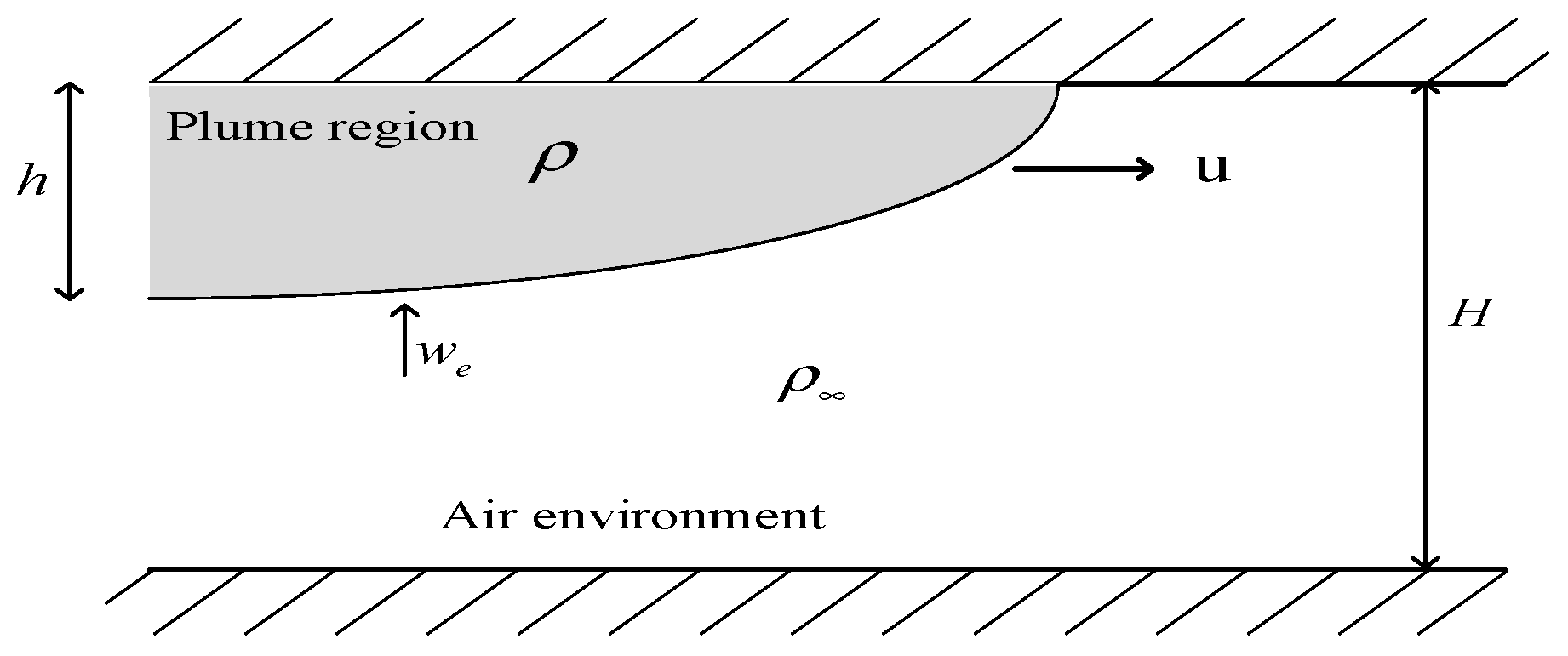


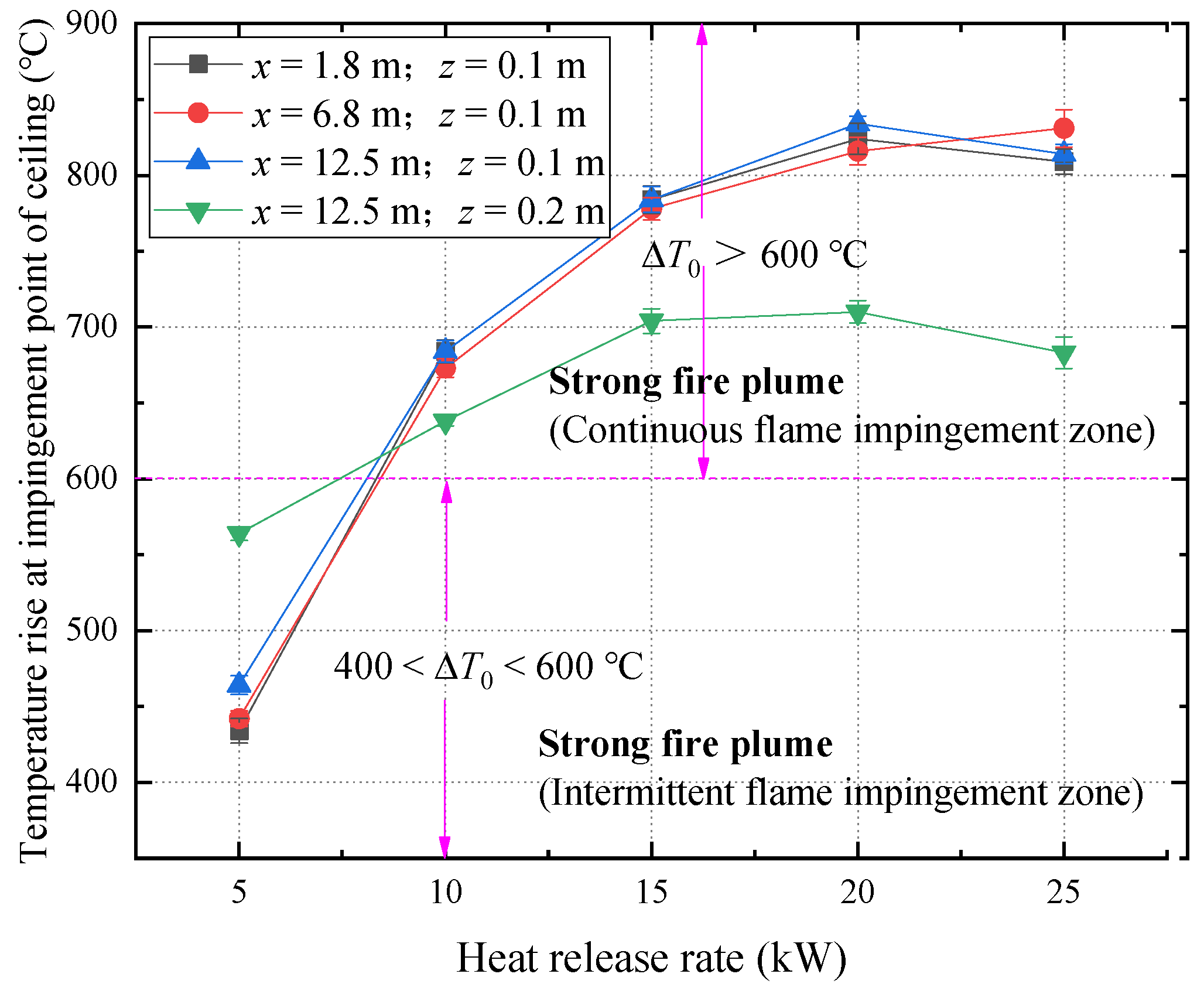
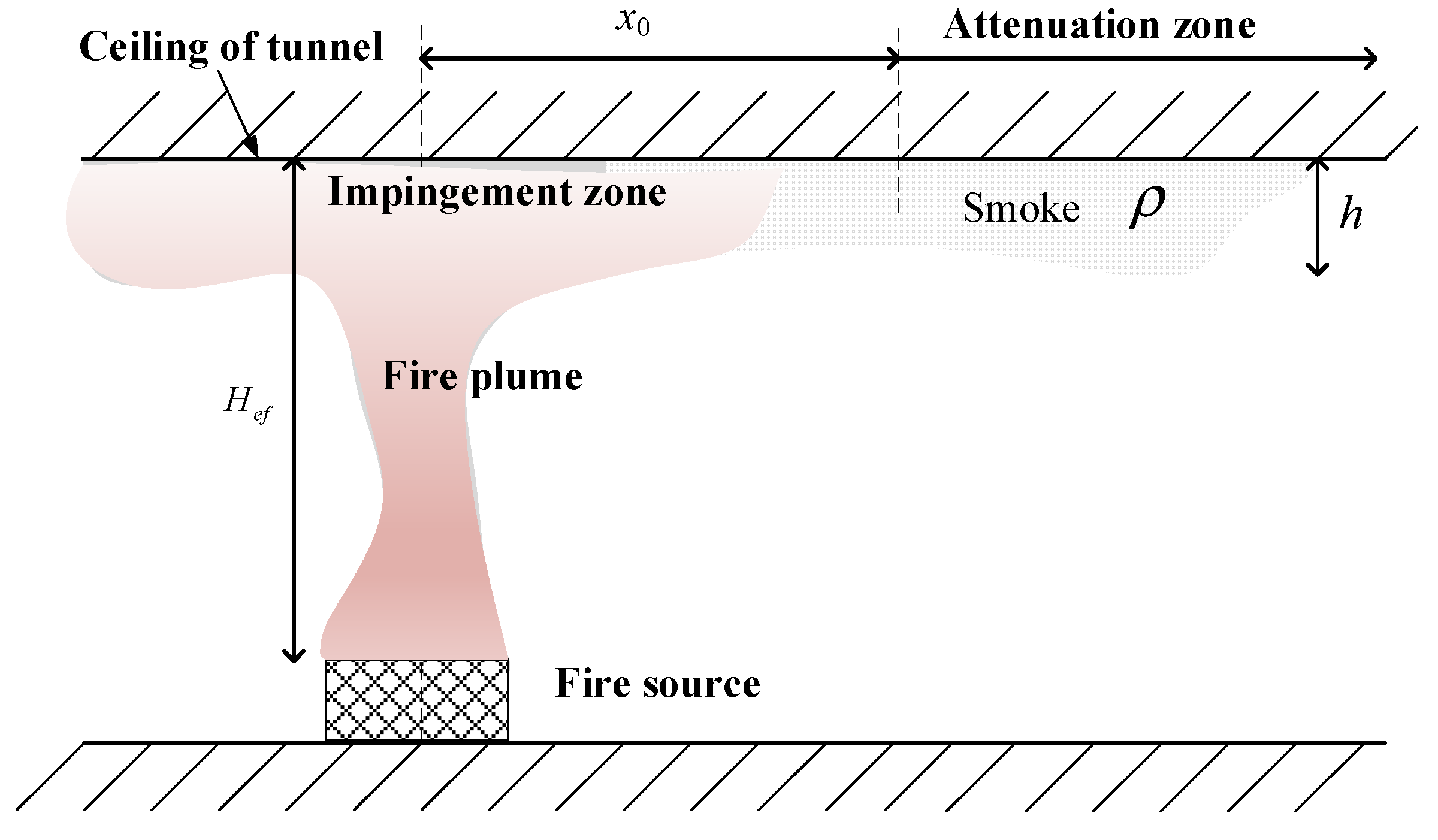
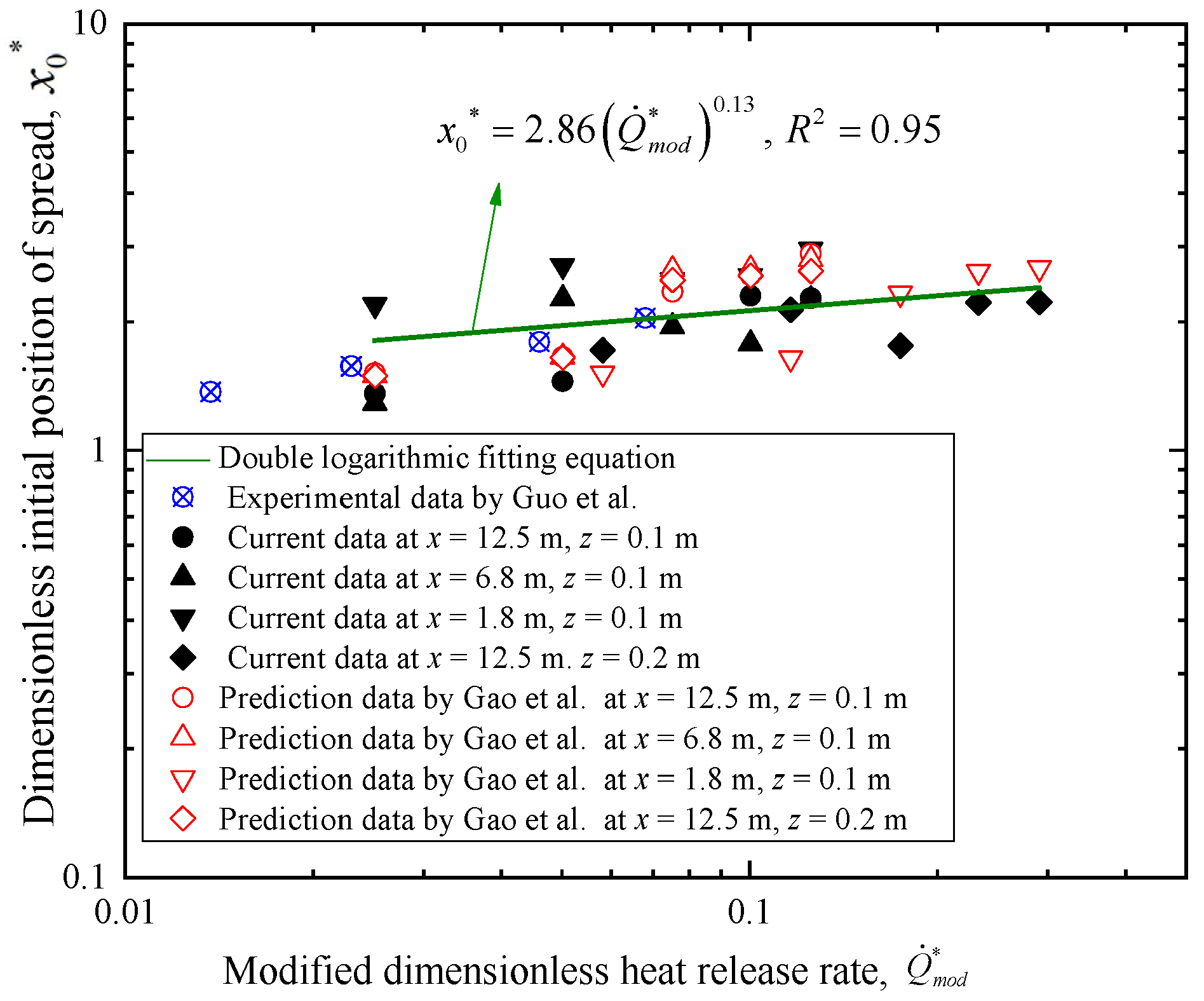

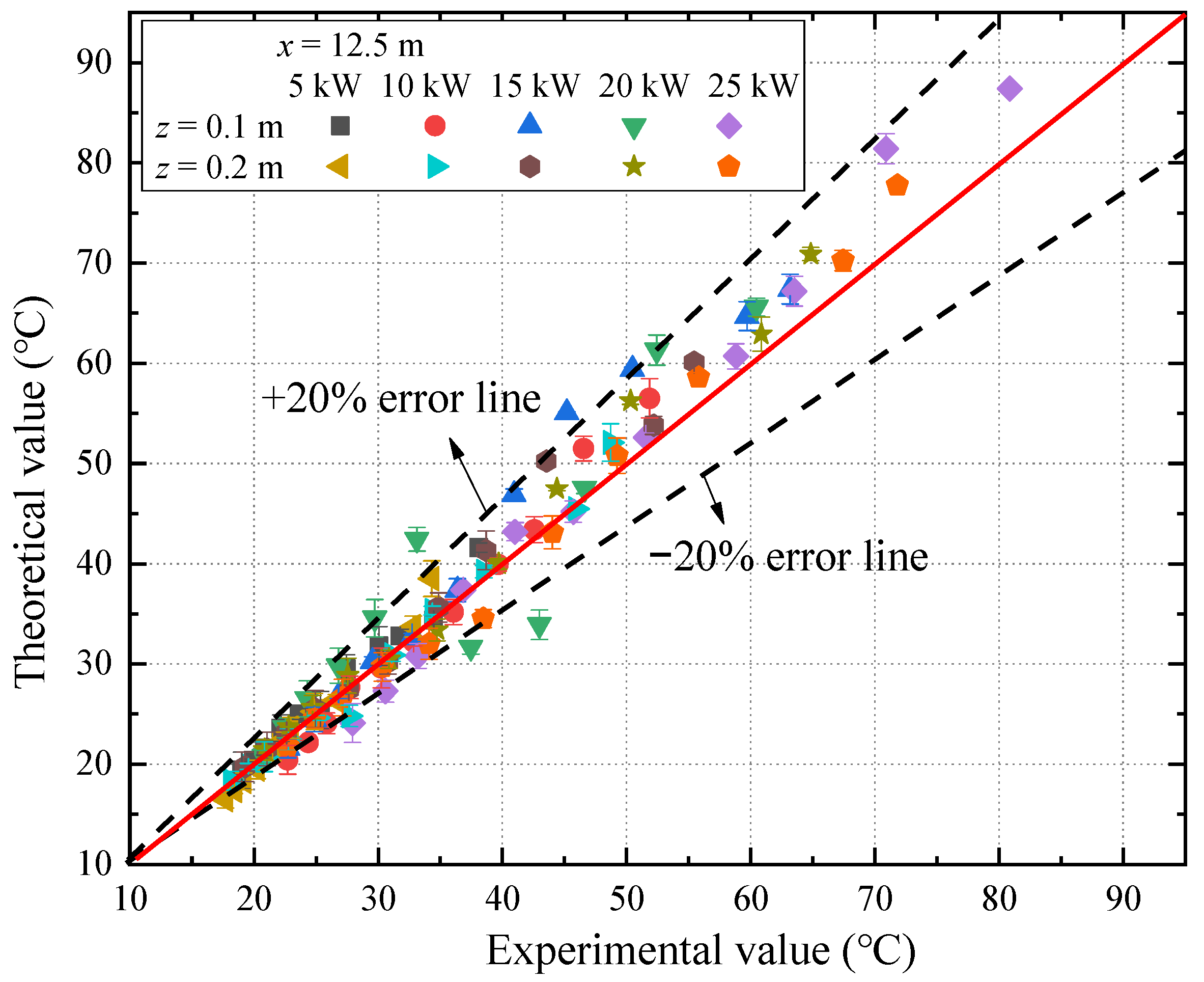
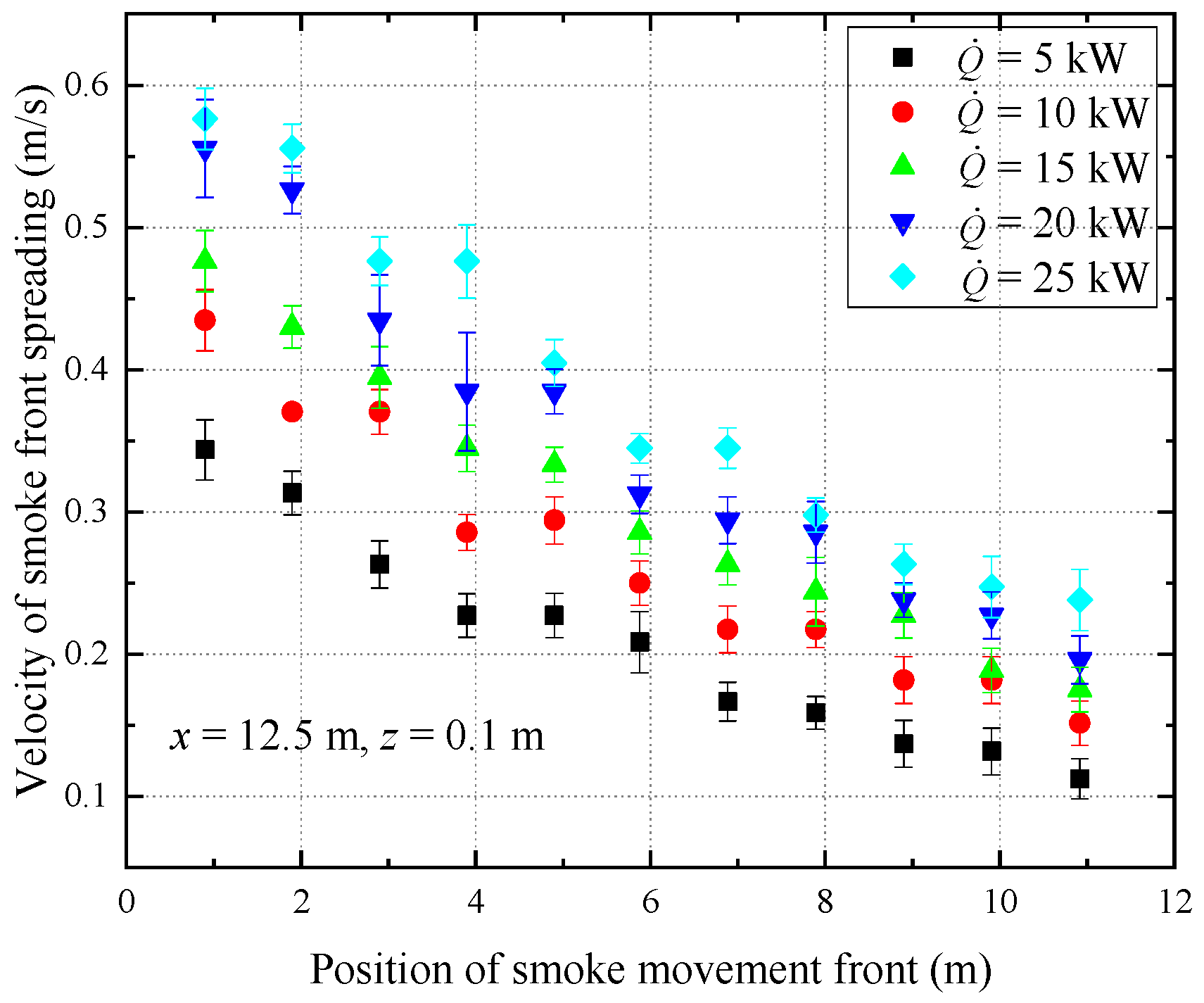
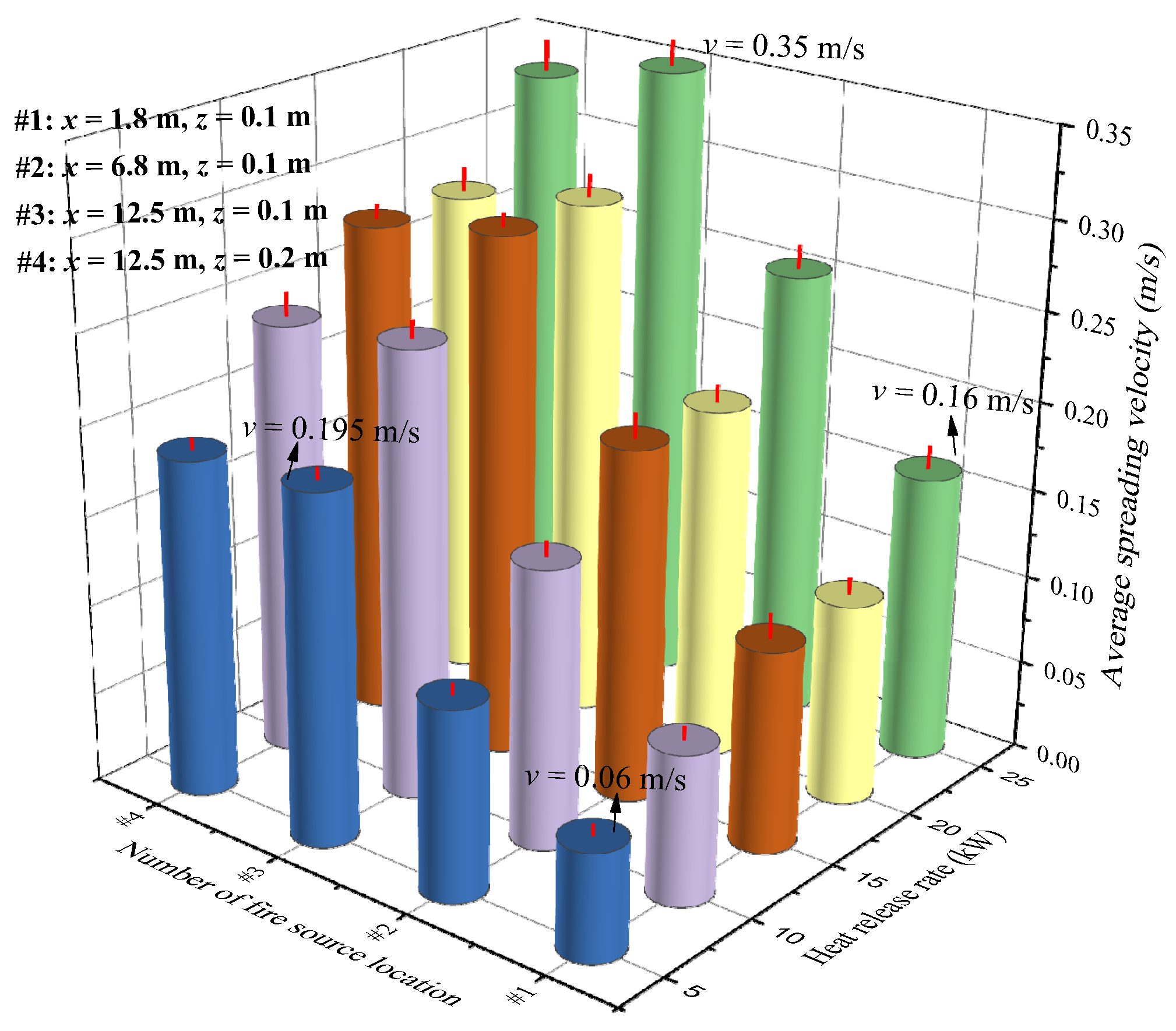
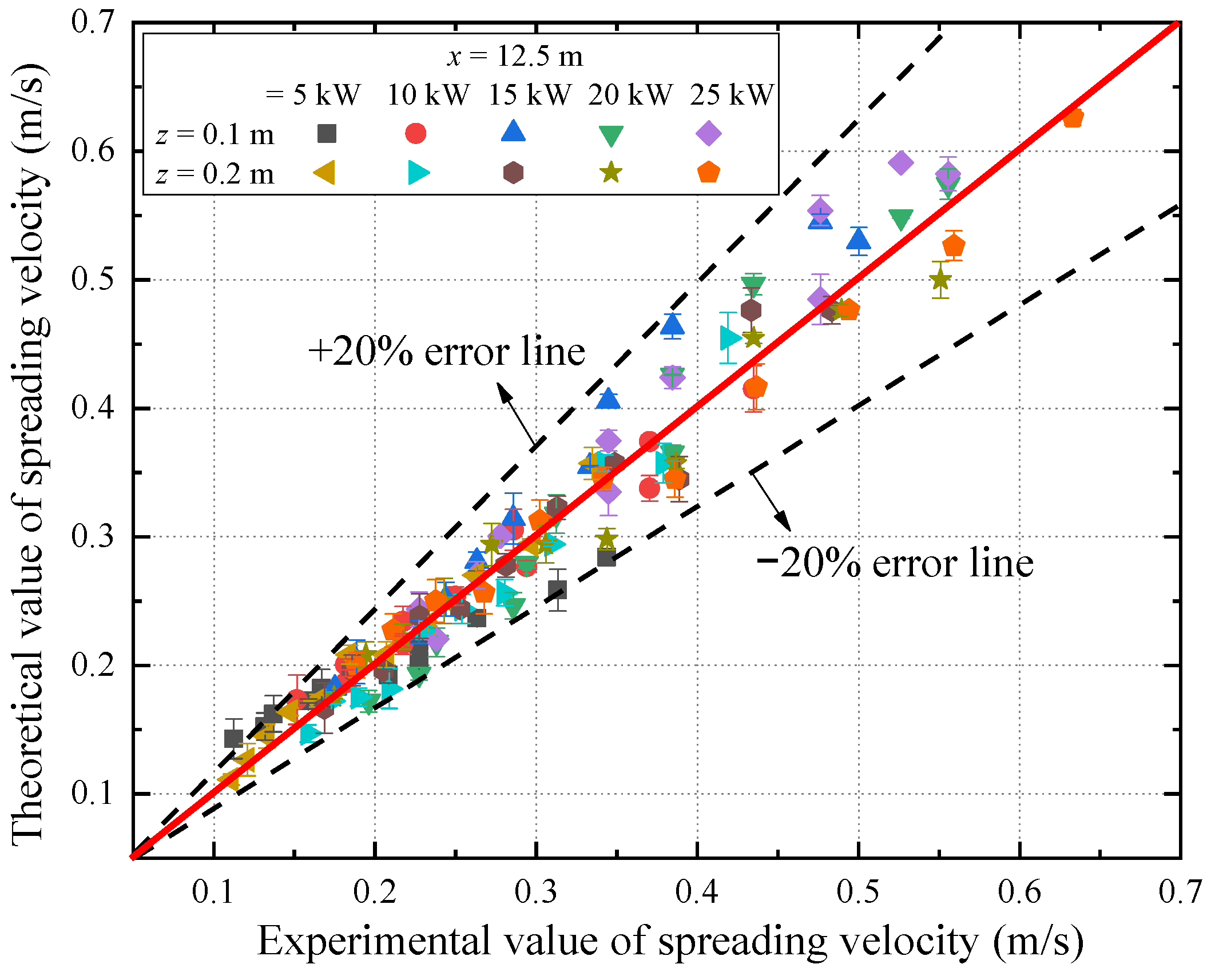
| Longitudinal Position of A Fire Source, x (m) | Vertical Position of A Fire Source, z (m) | Flow Rate of Propane (L/min) | HRR (kW) |
|---|---|---|---|
| 1.8 | 0.1 | 3.3 | 5 |
| 6.5 | 10 | ||
| 9.8 | 15 | ||
| 13.2 | 20 | ||
| 16.5 | 25 | ||
| 6.8 | 0.1 | 3.3 | 5 |
| 6.5 | 10 | ||
| 9.8 | 15 | ||
| 13.2 | 20 | ||
| 16.5 | 25 | ||
| 12.5 | 0.1 | 3.3 | 5 |
| 6.5 | 10 | ||
| 9.8 | 15 | ||
| 13.2 | 20 | ||
| 16.5 | 25 | ||
| 12.5 | 0.2 | 3.3 | 5 |
| 6.5 | 10 | ||
| 9.8 | 15 | ||
| 13.2 | 20 | ||
| 16.5 | 25 |
Disclaimer/Publisher’s Note: The statements, opinions and data contained in all publications are solely those of the individual author(s) and contributor(s) and not of MDPI and/or the editor(s). MDPI and/or the editor(s) disclaim responsibility for any injury to people or property resulting from any ideas, methods, instructions or products referred to in the content. |
© 2024 by the authors. Licensee MDPI, Basel, Switzerland. This article is an open access article distributed under the terms and conditions of the Creative Commons Attribution (CC BY) license (https://creativecommons.org/licenses/by/4.0/).
Share and Cite
Cao, B.; Liu, H.; Fan, R.; Ju, X.; Yang, L. Experimental and Theoretical Investigation of Longitudinal Temperature Attenuation and Smoke Movement in Urban Utility Tunnel Fires. Fire 2024, 7, 123. https://doi.org/10.3390/fire7040123
Cao B, Liu H, Fan R, Ju X, Yang L. Experimental and Theoretical Investigation of Longitudinal Temperature Attenuation and Smoke Movement in Urban Utility Tunnel Fires. Fire. 2024; 7(4):123. https://doi.org/10.3390/fire7040123
Chicago/Turabian StyleCao, Biteng, Hong Liu, Rui Fan, Xiaoyu Ju, and Lizhong Yang. 2024. "Experimental and Theoretical Investigation of Longitudinal Temperature Attenuation and Smoke Movement in Urban Utility Tunnel Fires" Fire 7, no. 4: 123. https://doi.org/10.3390/fire7040123
APA StyleCao, B., Liu, H., Fan, R., Ju, X., & Yang, L. (2024). Experimental and Theoretical Investigation of Longitudinal Temperature Attenuation and Smoke Movement in Urban Utility Tunnel Fires. Fire, 7(4), 123. https://doi.org/10.3390/fire7040123







